This is a very personal story of one particular day, but it should be helpful, I hope, to people carrying out all sorts of research in Cornwall. It started with my grandmother’s family. I did not know much about them and so I carried out some online research. Their name was Grey and they lived in Falmouth. Census returns and other online archive material started building a picture of my great grandfather, Richard Orlando Grey, who was a crane driver at Falmouth docks, and his parents Richard Parnell Grey and Thirza Moyle.
Armed with census returns, I set off to find the places in Falmouth where the Grey family lived in the later nineteenth and early twentieth centuries. Who says family research needs to happen indoors? To get a different perspective it is great to find the places associated with the family in question and see where they lived on the ground; the roads they walked along, the houses they lived in and the places where they worked. This has the name; “experiential research” and was defined back in 1994 as “information and wisdom gained from lived experience”[1]. This suggests there is value in direct engagement by the researcher to gain knowledge and better understanding of a subject. It certainly had a value to me, and helped me to understand better the physical spaces that these people lived in.
One thing that maps and pictures can never truly convey is how a place relates to the person. So putting yourself in that place helps you understand the space these people inhabited. Some spaces feel big, open and convey perhaps affluence, or at least relative affluence. Other spaces feel cramped and small, and may convey poverty, or limitations. The views of these spaces, and from them, also conveys more impressions that may otherwise be missed. Walking along those streets helped me to appreciate the scales on the map, and the heights between places that people used to traverse. In Falmouth, before a system of sewerage was installed, the higher you lived then the better off you were. An ad-hoc approach to development means that houses lower down the hill may have been closer to the docks, but they were also more likely to have been affected by sewerage from the houses higher up the hill.
It is useful to bear in mind the limitations of this approach; I was walking this place now in the present day, and so the views I saw were different from the views that my forebears would have seen. Some of the buildings were the same, others were different and it is not always clear which spaces have undergone most change and which have undergone least. There were no cars; people dressed differently making the past truly another country. Likewise, the sounds and smells would have been different in the past, although seaweed and herring gulls probably smell bad in any century.
Falmouth has undergone many changes in even such a short time, and so online research was only able to find some of the houses they had lived in. For instance, Richard Orlando Grey lived with both his parents in Waterloo Road in 1901, while his parents occupied another house on Waterloo Road in 1891 before Richard was born. Both houses are still standing and I found them relatively easily.
Sadly, number 36 Killigrew Street proved harder to find. Ancestry has a register from 1939 and in that year, 70 year old Richard Parnell Grey and his 67 year old wife Thirza Jane Grey lived at No 36 Killigrew Street. I walked around Killigrew Street, and popped into Choak’s shop at number 30 because I could not find the number. They were making pasties, but paused to tell me that they thought number 36 was opposite.
All the photographs and images in this article are copyright. The photographs below are not licensed for gain, commercial or public use, or use in the public domain. Full copyrights retained by Falmouth History Archive at The Poly and Matt Blewett respectively. High resolution versions of historical photographs are available to view at the Falmouth History Archive. Special thanks to the archive for permission to display selected images here.
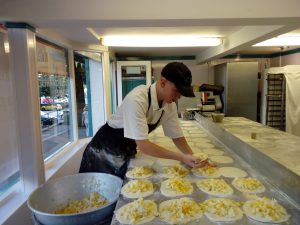
Online research can be misleading. Before I set off on my walk, I had used Google maps to find as many locations as I could, and in 1881 Richard Parnell Grey lived with his wife Thirza Grey at No 15 Webber Street, along with her brother’s family. Google Maps seemed to indicate that this location was now the site of funeral directors W.J. Angove & Son. However, walking along Webber Street I discovered that number 15 is actually now the Rising Dragon.
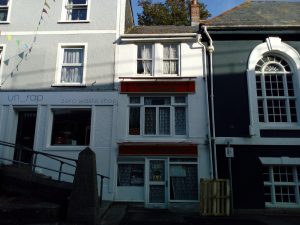
Of course, principles of research suggest that you should always check your sources and nothing beats visiting the place. However, how often do we take online data at face value, and assume it is correct without checking it further?
When conducting research, whether it is family research, local history, or wider studies, it helps to know what additional sources of information are available. We should hope that everyone is now aware of Cornwall’s National Library at Kresen Kernow. However, there are many other archives with many different resources with different levels of access. One such resource is the Falmouth History Archive which you can find at the Poly in Falmouth’s Church Street.
I first contacted the Falmouth History Archive when I found addresses for the Grey family in census returns, and I could not find their location using online resources. They were able to give me some information about the sites mentioned, and so after visiting the places to see what was there now, I popped into the Poly and met them.

They were really friendly and happy to show me how to search their database. They have a huge archive on Falmouth, including many books, maps and papers, but I was particularly searching for photographs and they have a digitised collection that you can browse, and buy pictures you particularly want. However, you are only allowed to use them under license, which usually includes not sharing them with third parties – so if the University of Exeter cannot lock these photos we will not be able to share them with you here!
I had previously asked where “Old Post Office Yard” is, or was, and the staff at the Falmouth History Archive told me that its entrance was “between 17 and 18 Market Street”, and so it is on this map:
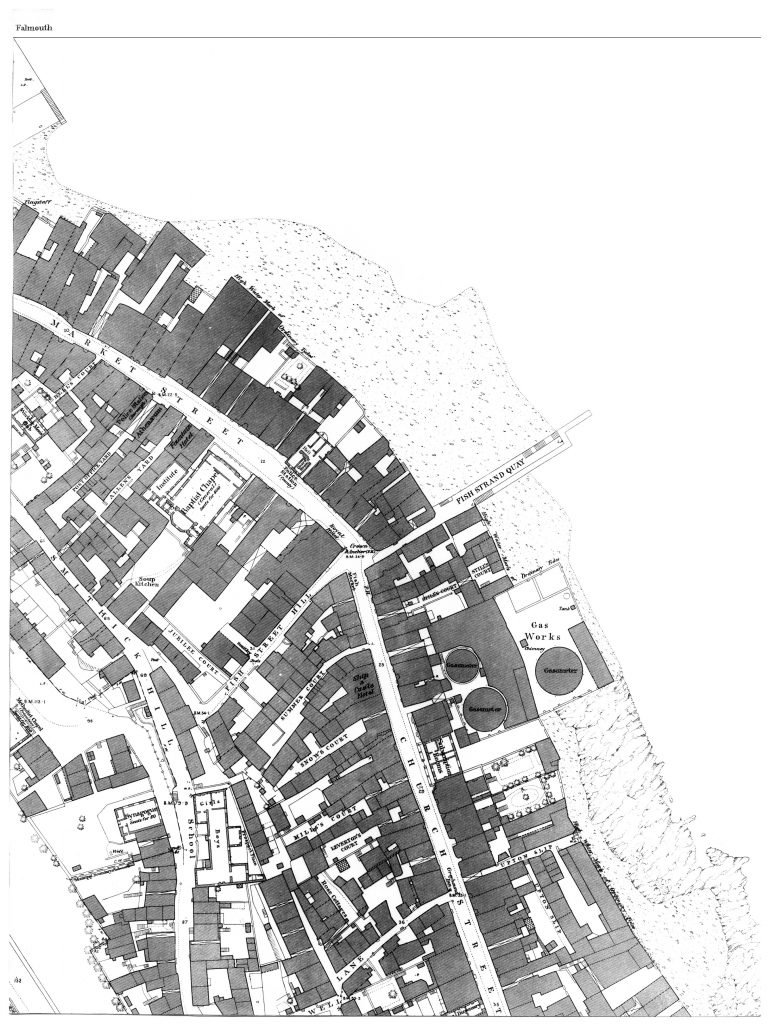
I searched for number 17 and 18 Market Street, but I only found WH Smith. The staff there were really helpful, and confirmed that their address was indeed 17 and 18 Market Street – the access to Old Post Office Yard no longer exists.
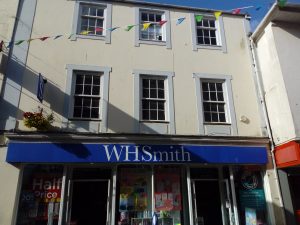
Thankfully, the archive group had photos of the yard. This was where the Grey family lived in 1911, and one researcher told me that was a relief that it was not the adjacent yard – Allen’s Yard – which was where the prostitutes lived. If you want to see that, then I am afraid you are just going to have to visit the archive yourself!

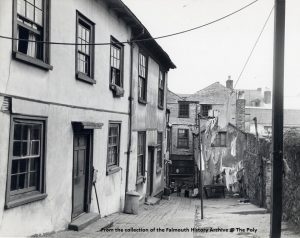

Going back to Killigrew Street, I took a photo opposite Choak’s bakery and you can compare it with the image of Cross Row that stood on the spot before. Number 36 Killigrew Street is just visible on the far left of the old photo.
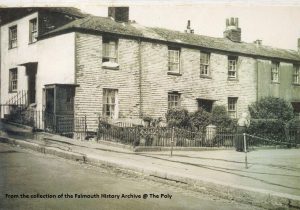
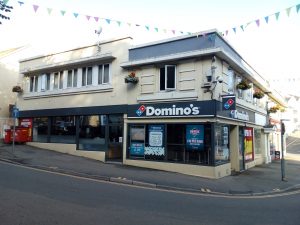
Back in 1871 Richard Parnell Gray lived with his parents in Mill house Row. The Falmouth Archive told me “Mill (house) Row was a group of dwellings on the west side of New Street between Higher Quay Hill and Swanpool Street. It was named from the water mill that once occupied the site where the Friends Meeting House was built.”
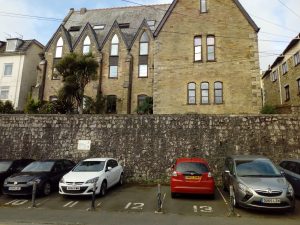
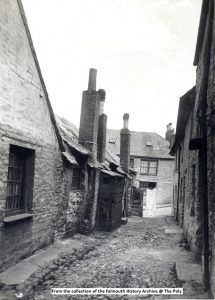
The Falmouth History Archive proved very helpful in finding Falmouth’s lost places, and more often than not had amazing photographs of them. The added extra dimension for me was the information it imparted to me about my own family, and how they used to live. The different houses show very different places of Falmouth, and seem to suggest changing social and economic standing. They potentially demonstrate the undulating fortunes of several generations of the same family as they lived in different parts of this fascinating town.
While this was a very personal journey, it was one that mixed experiential and archival research together producing a better insight into Falmouth as a place now and in the past. I would recommend this as a method for anyone conducting research, as while you can never truly experience the past, putting yourself physically in those spaces and considering how people in the past may have experienced them may provide insights and appreciation that desktop research alone will not provide. This can then complement archival and documentary research that can give an additional perspective that adds meaning to personal experience.
[1] Schubert, M. A., &Borkman, T.(1994).Identifying the experiential knowledge developed within a self-help group.

A very useful starting point for new directions in my own research
Thank you, I really enjoyed the walk. Splann o. So good to see that the Poly have such a good archive too.
The photo showing the rather large underpants is actually Allen’s Yard in Falmouth and not Old Post Office Yard. The other two photos of the latter are correct though.
Kind regards.
Hallo Matt, Thanks for this. I would like to send you a copy of “A Mis-Guide to Anywhere” by Wrights & Sites. The book champions the notion of walking as an arts practice and walking as away of sensing place in a way that is very different to on-line information or municipal interpretations of place. By the way, in your article you mention, “… in 1881 Richard Parnell Grey lived with his wife Thirza Grey at No 15 Webber Street, along with her brother’s family…” By coincidence I have a photo of 15 Webber Street, Falmouth taken in 1907 when it was Mrs Bailey’s Pie shop. It struck me as a fantastic example of psycho-geography that the same shop is now a Chinese Takeaway in the 21st Century.
Deth da Simon,
I would be really keen to see the photo from 1907 and would love a copy of “Mis-guide to anywhere”, murastawhy!
This is so interesting. I am researching the family of a young girl who stitched a sampler in Falmouth in 1835. She was nine. Her dad died in 1834 when she was 8. In 1841 she lived on Arwennack street with her mother and in 1851 lived at 38 killibrew with. her mom. Her mother was living with a daughter in 1861 in Liverpool and Ellen Devonshire the young stitcher married a man from Toxley Park Liverpool in 1853 so I think she left the area when her sister moved after the 1851 census.